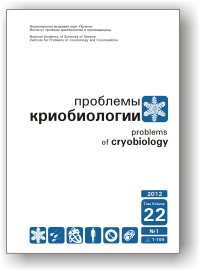КриоконÑервирование ÑуÑпензии клеток надпочечников новорожденных мышей. II. ВлиÑние концентраций Ñыворотки в ÑоÑтаве криозащитной Ñреды
Ключевые слова:
криоконÑервирование, надпочечники, новорожденные мыши, ДМСОАннотация
Изучали влиÑние концентраций фетальной телÑчьей Ñыворотки (ФТС) и диметилÑульфокÑида (ДМСО) в ÑоÑтаве криозащитной Ñреды на показатели жизнеÑпоÑобноÑти по иÑключению трипанового Ñинего, ÑохранноÑти количеÑтва и гормональной активноÑти клеток надпочечников новорожденных мышей поÑле замораживаниÑ-оттаиваниÑ. ИÑпользование Ñыворотки в концентрации 10 и 25% позволило увеличить количеÑтво жизнеÑпоÑобных клеток надпочечников новорожденных мышей по Ñравнению Ñ Ð±ÐµÑÑывороточными Ñредами. Ðаибольшие показатели жизнеÑпоÑобноÑти (от 71,4 до 76,0%) и ÑохранноÑти (99,0%) наблюдалиÑÑŒ поÑле замораживаниÑ-Ð¾Ñ‚Ñ‚Ð°Ð¸Ð²Ð°Ð½Ð¸Ñ ÐºÐ»ÐµÑ‚Ð¾Ðº надпочечников в Ñредах, Ñодержащих 10, 15, 20% ДМСО и 25% ФТС. Однако Ð³Ð¾Ñ€Ð¼Ð¾Ð½Ð°Ð»ÑŒÐ½Ð°Ñ Ð¸ Ð¿Ñ€Ð¾Ð»Ð¸Ñ„ÐµÑ€Ð°Ñ‚Ð¸Ð²Ð½Ð°Ñ Ð°ÐºÑ‚Ð¸Ð²Ð½Ð¾Ñти оказалиÑÑŒ Ñнижены по Ñравнению Ñ ÐºÐ¾Ð½Ñ‚Ñ€Ð¾Ð»ÑŒÐ½Ð¾Ð¹ культурой.
Библиографические ссылки
Dudetskaya G.V., Bozhok G.A., Bondarenko T.P. Effect of cooling rate on integrity of zone-differentiated adrenal cell populations of rats. Problems of Cryobiology 2010; 20 (4): 379–387.
Tamarina I.V., Bozhok G.A., Gurina T.M. et al. Cryopreservation of newborn mice adrenal cell suspension: I. Concentration effect of DMSO as cryoprotective medium component. Problems of Cryobiology; 22 (1): 79–87.
Ustichenko V.D. Functional properties of newborn piglets’ adrenal glands during effect of different freezing regimens [Author’s Abstract of the Thesis ... Candidate of Biological Sciences]. Kharkiv, 2008.
Sidorenko O.S., Bozhok G.A., Legach E.I. et al. Study of pos-sibility to derive and cryopreserve adrenal cell primary culture of newborn piglets. Problems of Cryobiology 2011; 21 (1): 58–67.
Ansurudeen I., Kopprasch S., Ehrhart-Bornstein M. et al. Endothelial cell-mediated regulation of aldosterone release from human adrenocortical cells. Mol Cel Endocr 2007; 265 (3): 150–156.
Dimasi L., Chirkova L., Malbasic M. et al. Recombinant albumin – its role in cryopreservation and cell recovery. [web-site] http://www.novofarma.biozymes.com/en/information-centre/posters-and-presentations/Documents/Recombinant_albumin_%E2%80%93_role_in_cryopreservation_ and_cell[1].pdf (18.11.2012).
Fahy G., Lilley T., Linsdell H. et al. Cryoprotectant toxicity and cryoprotectant toxicity reduction: In search of molecular mechanisms. Cryobiology 1990; 27 (3): 247–268.
Flevaris P., Stojanovich A., Gong H. et al. A molecular switch that controls cell spreading and retraction. JCB 2007; 179 (3): 553–565.
Grill G., Porcellini A., Lucarelli G. Role of serum on cryopreservation and subsequent viability of mouse bone marrow hemopoetic stem cells. Cryobiology 1980; 17 (5): 516–520.
Hreinsson J., Zhang P., Swahn M. et al. Cryopreservation of follicles in human ovarian cortical tissue. Comparison of serum and human serum albumin in the cryoprotectant solutions. Hum Reprod 2003; 18 (11): 2420–2428.
Malinin G. Cytotoxic effect of dimethylsulfoxide on the ultra-structure of cultured Rhesus kidney cells. Cryobiology 1973; 10 (1): 22–32.
Menorval M., Mir M., Fernendez L. et al. Effects of dimethyl sulfoxide in cholesterol-containing lipid membranes: a comparative study of experiments in silico and with cells. PLoS 2012; (7): e41733.
O'Hare M., Neville A. Morphological responses to corticotrophin and cyclic AMP by adult rat adrenocortical cells in monolayer culture. J Endocrinol 1973; 56 (3): 529–536.
Pogorelyi V. K., Turov V. V., Turov A. V. et al. Reaction of serum albumin with dimethyl sulfoxide according to PMR spectra of frozen aqueous solutions. Theor Exp Chem 1989; 25 (1): 93–97.
Qi W., Ding D., Salvi R., Cytotoxic effects of dimethyl sulphoxide (DMSO) on cochlear organotypic cultures. Hear Res 2008; 236: 52–60.
Rossi C., Bridgman C., Kiesel G. Viral contamination of bovine fetal lung cultures and bovine fetal serum. Am J Vet Res 1980; 41 (10): 1680–1681.
Santori C., Di Veroli C., Di Lazzaro F. et al. High prevalence of thyroid disfunction in primary hyperaldosteronism. Recenti Prog Med 2005; 96 (7–8): 352–356.
Sasaki M., Kato Y., Yamada H. et al. Development of a novel serum–free freezing medium for mammalian cells using the silk protein sericin. Biotechnol Appl Biochem 2005; 42: 183–188.
Till H., Stachel D., Muller-Hocker J. et al. Cryopreservation and transplantation of fetal adrenal glands in adrenalectomized rats. Eur J Pediatr Surg 1998; 8 (4): 240–243.
Unsicker K., Allmendinger A., Stoeckel E. et al. Development of adrenal chromaffin cells is largely normal in mice lacking the receptor tyrosine kinase c-Ret. Mech Dev 2003; 120 (3): 299–304.
Unsicker K., Huber K., Schutz G. et al. The chromaffin cell and its development. Neurochem Res 2005; 30 (6–7): 921–925.
Villa S., Schutz I., Mainini E. et al. Probable role of obesity on the adrenal response to acute stimulation with adrenocorticotrophic hormone in eumenorrheic and hirsute, non-eumenorrheic women. Minerva Endocrinol 1993; 18 (1): 9–13.
Загрузки
Опубликован
Как цитировать
Выпуск
Раздел
Лицензия
Copyright (c) 2020 Irina V. Tamarina, Galina A. Bozhok, Tatyana M. Gurina, Nina F. Gubina, Tatyana P. Bondarenko

Это произведение доступно по лицензии Creative Commons «Attribution» («Атрибуция») 4.0 Всемирная.
Авторы, публикующие в данном журнале, соглашаются со следующим:
- Авторы сохраняют за собой авторские права на работу и предоставляют журналу право первой публикации работы на условиях лицензии Creative Commons Attribution License, которая позволяет другим распространять данную работу с обязательным сохранением ссылок на авторов оригинальной работы и оригинальную публикацию в этом журнале.
- Авторы сохраняют право заключать отдельные контрактные договоренности, касающиеся не-эксклюзивного распространения версии работы в опубликованном здесь виде (например, размещение ее в институтском хранилище, публикацию в книге), со ссылкой на ее оригинальную публикацию в этом журнале.
- Авторы имеют право размещать их работу в сети Интернет (например в институтском хранилище или персональном сайте) до и во время процесса рассмотрения ее данным журналом, так как это может привести к продуктивному обсуждению и большему количеству ссылок на данную работу (См. The Effect of Open Access).




